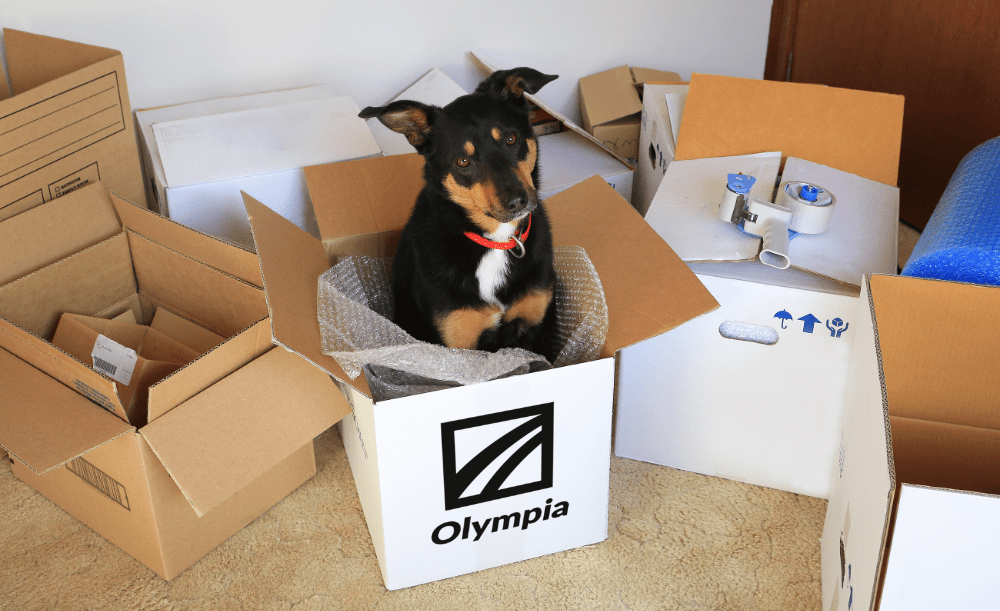Why Moving With Pets Is So Hard

Let’s be honest, moving is a big deal. It’s exciting, yes, but also overwhelming. And when you look at it from your pet’s perspective, you start to see why moving with pets is so hard. They have no idea what’s going on. One day the couch is there, the next it’s gone. Strangers are coming in and out. Boxes are everywhere. It’s no wonder so many pets struggle with moving.
That’s why we’ve created this guide, to make moving with pets easier, calmer, and more manageable for everyone involved.
Setting the Stage for Success: Schedule a Vet Visit
A pre-move vet visit is one of the most important steps you can take. This ensures your pet is physically fit for travel, especially if you’re moving long-distance or flying. Use this opportunity to get your pet up to date on vaccinations, refill prescriptions, and ask for advice specific to their breed, age, or temperament. Many vets can also provide calming products or motion sickness medication tailored to your pet’s needs. Don’t forget to request printed copies of medical records—especially if you’re switching vets in your new location.
Update Tags and Microchip Info
It’s surprisingly common for pets to slip out during the hustle of moving day or while exploring a new neighborhood. Make sure your pet’s ID tags are legible and securely fastened to their collar. If they’re microchipped, call your provider or log into your account to verify that your phone number and address are current. A simple update can mean the difference between hours of panic and a safe return home.
Keep Daily Routines as Normal as Possible
Pets thrive on predictability. With boxes piling up and routines shifting, sticking to their regular feeding, walking, and bedtime schedule can help them feel more grounded. Try to maintain familiar cues: the same food, the same walking route, even the same tone of voice and energy. If your pet is used to certain playtimes or morning rituals, keep those going as long as possible—even if the rest of your house is in chaos.
Introduce the Travel Crate Early
If your pet isn’t used to a carrier or crate, it can be a major source of stress on moving day. Introduce the crate at least two weeks before your move. Keep it in a common area, propped open, and place treats, toys, or bedding inside to make it inviting. Encourage your pet to spend time inside it without pressure. For dogs, consider short trial car rides in the crate to build comfort. A familiar crate will feel like a safe haven when the real travel begins.
Keep it Calm and Controlled
Moving day can be complete chaos: loud noises, open doors, unfamiliar people, and the scent of stress in the air. For pets, this combination can trigger anxiety or escape behavior. Set aside a dedicated space—like a closed bedroom or bathroom—where your pet can stay safely out of the action. Stock it with their favorite items, and check in regularly. If possible, have a friend, neighbor, or pet sitter watch them offsite for the day. A calm, quiet environment will go a long way in protecting their wellbeing and keeping things smooth for your movers.
What to Watch For After the Move
Even after the boxes are unpacked, your pet may still be processing the change. Watch closely for signs that they’re feeling stressed or unwell. Common indicators include:
- Changes in appetite – eating significantly more or less than usual
- Hiding or clinginess – withdrawing to secluded spots or refusing to leave your side
- House accidents – urinating or defecating indoors despite being house-trained
- Excessive vocalization or aggression – increased barking, meowing, hissing, growling, or sudden irritability
These behaviors can be a normal part of adjustment, but if they persist or worsen, it could point to anxiety, illness, or injury. When in doubt, consult your veterinarian promptly to ensure your pet’s health and comfort are protected.
Final Thought: A Calm = A Smooth Move
A move isn’t just a change of address—it’s a life transition for every member of the household, including the ones with paws, claws, or feathers. Your pet doesn’t care about square footage or curb appeal; they care about safety, comfort, and the bond they share with you. By preparing thoughtfully, maintaining routines, and easing them into their new surroundings, you’re not just moving your belongings—you’re moving their sense of home.
Whether you’re staging a property for sale, downsizing to simplify life, or settling into your forever home, remember that your pet is experiencing every step alongside you. Treat the move as a shared journey, and you’ll not only reduce their stress—you’ll strengthen the trust and connection that makes them part of the family. Let’s make sure this move isn’t just smooth, but a positive new chapter for both of you.
Want Expert Relocation Advice?
At Olympia Moving & Storage, we’ve helped thousands of families relocate—each with its own unique needs, challenges, and stories. We understand that some aspects of a move require more than muscle—they require thoughtfulness, timing, and care. Whether it’s planning around pets, fragile items, or custom logistics, our team is here to guide you every step of the way. Book Your Move Today or email us at info@olympiamoving.com for expert consultation.



